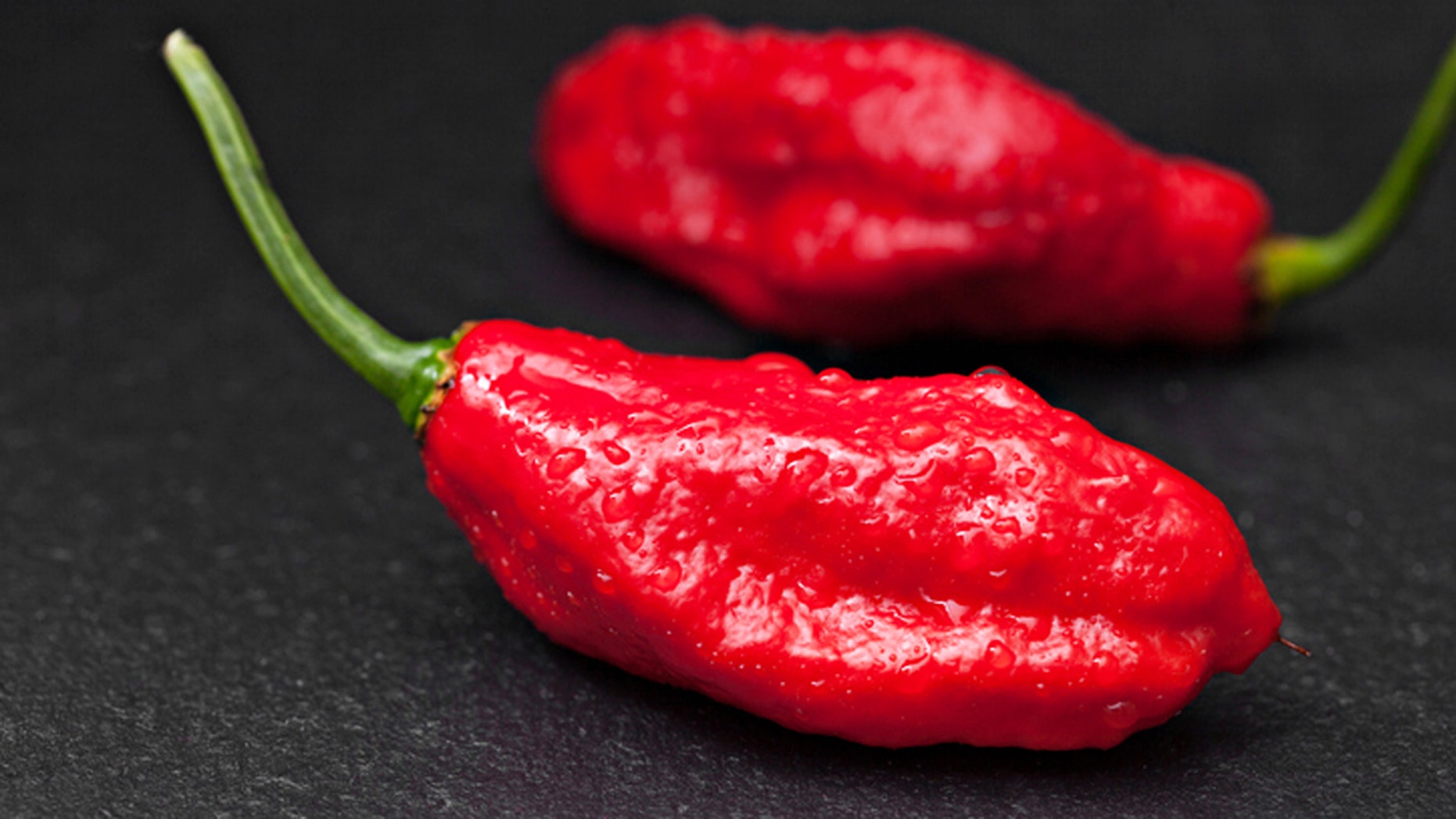

^ It is extensively cultivated in northeastern India, especially in the states of Assam, Nagaland and Manipur. It takes about 7–12 days to germinate at 32–38 ☌. The rough fruit plants are taller, with more fragile branches, while the smooth fruit plants yield more fruit and are compact with sturdier branches. However, the red fruit variety has two different types: the rough, dented fruit and the smooth fruit. Ghost pepper pods are unique among peppers because of their characteristic shape and very thin skin. The unselected strain of ghost peppers from India is an extremely variable plant, with a wide range in fruit sizes and fruit production per plant. Ripe peppers measure 60 to 85 mm (2.4 to 3.3 in) in length and 25 to 30 mm (1.0 to 1.2 in) in width with a red, yellow, orange, or chocolate color. Unlike most peppers, ghost peppers produce capsaicin in vesicles found in both the placenta around the seeds and throughout the fruit, rather than just in the placenta. In 2005, New Mexico State University's Chile Pepper Institute in Las Cruces, New Mexico found ghost peppers grown from seed in southern New Mexico to have a Scoville rating of 1,001,304 SHUs by HPLC. For comparison, Tabasco red pepper sauce rates at 2,500–5,000, and pure capsaicin (the chemical responsible for the pungency of pepper plants) rates at 16,000,000 SHUs. In 2000, India's Defence Research Laboratory (DRL) reported a Scoville rating for the ghost pepper of 855,000 SHUs, and in 2004 a rating of 1,041,427 SHUs was made using HPLC analysis. In northeastern India, the bhut jolokia is also known as the king chilli or king cobra chilli. In Manipur, the chili is called umorok or oo-morok ('tree chili'). It has also been called the Tezpur chili after the Assamese city of Tezpur. Other usages on the subcontinent are Saga jolokia, Indian mystery chili and Indian rough chili. This name is especially common in other regions where it is grown, such as Assam and Manipur. Similarly, in Nagaland, one of the regions of cultivation, the chili is called Naga jolokia ('Naga chili' also romanized nôga zôlôkia) and bhut jolokia (also romanized bhût zôlôkiya). In Assam, the pepper is also known as bih zôlôkia ('poison chili'), from Assamese bih 'poison' and zôlôkia 'chili pepper,' denoting the plant's heat. Labels Light Systems Mrs.The name bhüt jolokia (ভোট জলকীয়া) means Bhutanese pepper in Assamese the first element bhüt, meaning Bhutan, was mistakenly confused for a near- homonym bhut meaning ghost. :max_bytes(150000):strip_icc()/GettyImages-505694816-8c04940ee4054142b4de1eb500f6cd5f.jpg)
Garden Tools & Accessories Greenhouses Heating Mats & Cables Jiffy Products Kitchen Helpers.Books Composting Fertilizer Garden Decor Garden Helpers.Radish Seeds Seed Sales Squash Seeds Swiss Chard Tomatillo Seeds Watermelon Seeds Zucchini.Kalette Kohlrabi Lettuce Seeds Mesclun Muskmelon Seeds Onion Seeds Pak Choi.Broccoli Seeds Carrot Seeds Cauliflower Seeds Cucumber Seeds Eggplant Seeds Greens Ground Cherry Seeds.Ornamental Pepper Seeds Sweet Bell Pepper Seeds.Sweet Bell Pepper Plants Sweet Non-Bell Pepper Plants.Hot Pepper Plants Pepper Plant Collections.
GHOST PEPPER SERIES
Mountain Hybrid Series Paste Tomato Seeds Patio/Container Types Spotted Wilt Virus Resistant Tomato Seeds Wild Boar Series Tomato Seeds.Heirloom Tomato Seeds Indigo Collection Tomato Seeds Large Tomato Seeds Late Blight Resistant Tomato Seeds Medium-Large Tomato Seeds Medium-Small Tomato Seeds.Artisan Tomato Seeds Chef's Choice Cherry/Grape Tomato Seeds Goliath Tomato Seeds Greenhouse Tomatoes Hanging Basket Tomatoes.Large Slicing Tomato Plants Paste Tomato Tomato Plant Collections.Cherry/Grape Tomato Plants Goliath Tomato Plants Heirloom Tomato Plants.Welcome Totally Tomatoes Catalog Customers!.Spotted Wilt Virus Resistant Tomato Seeds.Medium-Small Open Pollinated Tomato Seeds.



:max_bytes(150000):strip_icc()/GettyImages-505694816-8c04940ee4054142b4de1eb500f6cd5f.jpg)


 0 kommentar(er)
0 kommentar(er)
